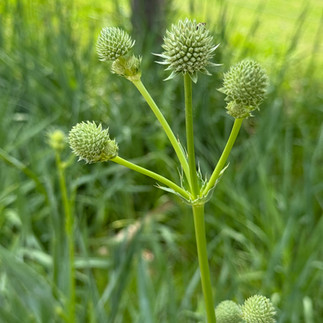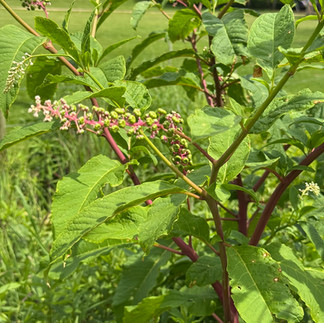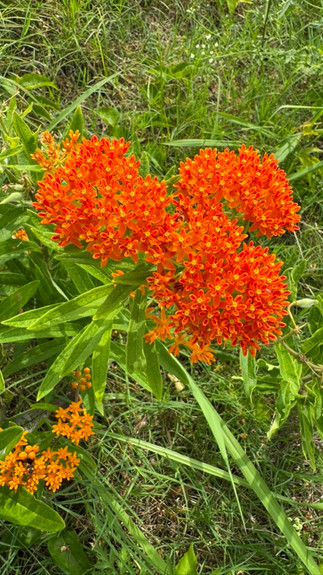MY LIFE WITH PLANTS: Memphis
- Jim Bishop
- Sep 1
- 6 min read
Text and photos by Jim Bishop, for Let's Talk Plants! September 2025
In June, I attended my second Garden Fling of the year in Memphis, Tennessee. Last year's event was in Seattle, and you can read my blog about it here Puget Sound Garden Fling 2024. Since 2008, the Fling has been a garden tour organized by local garden enthusiasts, focusing on different locations for bloggers, podcasters, social media gardeners, and anyone who writes and photographs gardens for the public.

Some Personal History
Let's rewind a bit for some personal history, back to August 16, 1977. That morning, my mom and I left Houston in my parent’s land-yacht, lemon-yellow Chrysler Newport. We were on our way to Columbus, Ohio, to visit my maternal grandmother. As we approached our first night's stop in Texarkana, we heard on the radio that Elvis had tragically passed away. The following afternoon, we drove through Memphis and got caught in a traffic jam near Elvis's house. It was my first visit to Memphis. The next year, I took a similar road trip with my first boyfriend to visit his parents in Evansville, Indiana. We stopped at Elvis's home while passing through Memphis. At that time, it wasn't yet a tourist spot, but I remember a trailer selling Elvis memorabilia. My next visit wouldn't be until almost 50 years later with The Garden Fling.
Memphis Has Gardens?
Memphis, you might think, seems like an unusual choice for a garden tour. I certainly had my doubts. Perhaps it was just my west coast, Southern California bias. However, I hoped it would remind me of my earlier gardening days in the Florida, Texas and midwest, where unlike the dry, brown summers of the west, summers were green, wet, and wonderful. It was also an opportunity to meet people I wouldn't normally encounter, broaden my horizons, and possibly enhance my blogging skills.
Well, it didn't disappoint. We even experienced an exciting thundershower one day while touring gardens. Everything was lush and green...however compared to San Diego, it was incredibly hot and humid.
In June, Memphis has average high temperatures around 88°F (31°C) and lows around 70°F (21°C). Rainfall in June occurs over about 12 days, with an average total of 3.4 to 3.8 inches.
Yikes! What was I thinking? Heavy humid air, that slows you down and soaking your clothing without even moving. Quite a shock, considering San Diego didn't reach 80 degrees in all of July this year.
The plants didn't disappoint either. So many species thrive in warm and wet conditions that we struggle to grow here, and should we try they never look as good as they do there. I particularly hoped to see crepe myrtles, caladiums, coleus, and rudbeckias. We encountered all of these and much more in abundance.
Touring with so many bloggers and writers, you can imagine they've already produced some excellent blogs about the various gardens we visited. So, I'm attempting to take a slightly different perspective on the gardens we explored and hopefully highlight a few aspects that others may have missed.
Public Gardens on the Mississippi

We began the first evening of the Fling by boarding buses in the afternoon and traveling to a series of parks along the Mississippi River. Thoughts of Huckleberry Finn, Ole Man River, and steamboats danced in my mind... I knew we wouldn't actually encounter any of these, but one can dream.
Instead, we were welcomed by beautiful green spaces featuring wide paths, intriguing artwork, an abundance of native southern plants, and thankfully, an air-conditioned visitor center dedicated to Elvis and B.B. King.
Our first view of some native plants:
Top Row -
Eryngium yuccifolium, rattlesnake master
Eryngium yuccifolium, rattlesnake master ( wider view)
Passiflora incarnata, purple passionflower
Middle Row -
Pycnanthemum muticum, mountain mint
Phytolacca americana, pokeweed
Baptisia, wild indigo
Bottom Row -
Sambucus, elderberry
Phytolacca americana, pokeweed
Passiflora lutea, yellow passionflower
Elvis and B.B. King statues.
Mosaic Memphis Egg - "Home of the Blues - Birth Place of Rock & Roll"
After a quick stop and cooldown at the visitor center, we boarded busses and headed a little down river to Tom Lee Park perched on rolling mounds high above the Mississippi River. Covering 31 acres walkways and paths meander through over 1000 trees and plants. It has become a model for riverfront revival.
Down closer to the river's edge grew Asclepias tuberosa, butterfly weed or milkweed. One sported a milkweed bug, Oncopeltus fasciatus. It looks identical to milkweed bugs in my home garden.
More native plants:
Top Row -
Magnolia virginiana, sweetbay magnolia
Monarda fistulosa, wild bergamot or bee balm
Rosa virginiana, wild rose
Bottom Row -
Rhus, Sumac
Oenothera speciosa, evening primrose
Rudbeckia hirta, black-eyed Susan

I found this unusual statue particularly interesting and moving once I knew the full story. I learned the statue and park commemorates, Tom Lee.
On May 8, 1925, the M.E. Norman set sail from Memphis with 72 men, women and children onboard for a trip to inspect revetment work at Pinckney Landing, two miles downriver of Memphis. The trip passed without incident until the boat ran into trouble on its return journey. The steamer capsized and its passengers were thrown into the fast and chilly current of the Mississippi River. Tom Lee, passing by in his small wooden skiff Zev, rescued 32 passengers from the numbing waters. His rescue was all the more remarkable as Lee himself could not swim.
Porches and Patios
Numerous gardens we visited were located in older Memphis neighborhoods, characterized by their charming houses built well before the advent of modern air conditioning technology. These historic homes, often adorned with unique architectural features, reflect a time when cooling off during the sweltering Memphis summers required creativity and resourcefulness. Given the long, hot, and humid summers that the region is known for, having an outdoor area where families could gather to escape the oppressive heat was not just a luxury but a necessity. These outdoor spaces provided a much-needed respite from the stifling indoor temperatures, allowing residents to enjoy the fresh air and the natural beauty of their surroundings.

These gardens and patios serve as excellent spots for socializing, fostering a strong sense of community among neighbors and friends. This sense of camaraderie was often reflected in the vibrant landscaping and thoughtful design of the gardens, which were meticulously tended to and served as a backdrop for gatherings. Here, you can still find cozy, imaginative, and occasionally elaborately decorated outdoor rooms that reflect the personalities and tastes of their owners. These spaces are often adorned with colorful flowers, comfortable seating, and artistic decor, creating inviting atmospheres. Homeowners have embraced the challenge of designing their outdoor areas to not only provide shade and comfort but also to serve as extensions of their living spaces.
Garden Art
Many of the gardens, if not the majority, featured some form of artwork, showcasing a diverse array of artistic expressions that enriched the natural beauty of the landscapes. These artistic elements ranged widely, encompassing everything from found objects creatively repurposed into unique sculptures to traditional folk art that reflected the cultural heritage of the region.
In some gardens, visitors could encounter whimsical installations made from everyday items, such as discarded tools, glass bottles, and pieces of wood, transformed into imaginative sculptures that sparked curiosity and conversation.
Overall, the presence of artwork in these gardens transformed them into more than just spaces for horticulture; they became immersive experiences that celebrated creativity, culture, and the connection between humanity and the natural world.
So, on the short trip to Memphis we saw a lot of gardens, had a lot of fun with friends and locals and learned a little about southern culture.
One final cool thing
On the flight out of Memphis as we flew over the mighty Mississippi I recalled this passage from "Life On the Mississippi" by Mark Twain about cut-offs where the course of the Mississippi is shorted by digging a ditch in the land between bends in the river:
"In the space of 176 years the lower Mississippi has shortened itself 242 miles. That is an average of a trifle over one mile and a third per year. Therefore, any calm person, who is not blind or idiotic, can see that in the Old Oolitic Silurian Period, just a million years ago next November, the lower Mississippi River was upwards of one million three hundred thousand miles long, and stuck out over the Gulf of Mexico like a fishing rod. And by the same token, any person can see that 742 years from now the lower Mississippi will be only a mile and 3 quarters long, and Cairo (Illinois) and New Orleans will have joined their streets together and be plodding comfortably along under a single mayor and a mutual board of aldermen. There is something fascinating about science. One gets such wholesale returns of conjecture out of such a trifling investment of fact."



















































